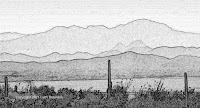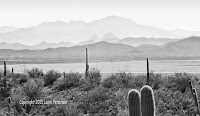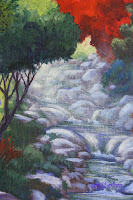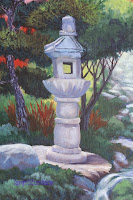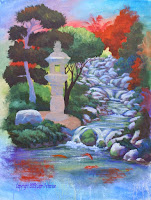Acrylic
101 – Landscape Scene
For
our final 2 weeks we started a simple landscape scene using all the techniques
we learned during this past semester so here is the step by step:
1.
With
your soft vine charcoal or chalk draw your horizon line approximately 2/3s from
the bottom of the canvas. This is all the drawing you will need to do for now.
2.
Lightly
mist the top portion of your canvas, this will help the gesso to go on your
canvas. If you have runny gesso you may not need to do this step.
3.
With
a larger bristle brush and your gesso cover the upper section with the gesso so
the entire sky area has a light coating of gesso with a scrubbing type stroke.
To check to see if you have too much or too little lightly touch the canvas you
should be able to see your skin color through it: Too little and there won’t be
much on your finger too much gesso and you will have a thick coating and
possible peaks of paint of gesso on your finger, if this happens, scrap some of
the gesso off with our brush and spread the remaining out to cover, test again.
We need the gesso to blend the colors of our next step if there is too much
gesso the colors will become too light. Remember you can always add the gesso
if you need it as you blend, it is hard to remove once you get started.
4.
While
the gesso is still wet, wipe out the brush you were using and pick up a
generous amount of your ultramarine blue on one corner and a touch or sienna
and purple on the other corner you will brush blend these colors by streaking
the brush across the top of the canvas until most of the color is off your
brush, wipe the brush again then using long crisscross strokes starting at the
top and working across then down, move and blend the color down to the horizon
line and be sure that you take the color a little beyond the line you drew so
you will be sure that the sky is behind everything. You may need to wipe your
brush often and don’t over mix these colors, you want what is called a “graded
color” so that it is darker at the top than it is at the bottom. If you want a
nice smooth blended sky you can use your soft blending brush using long
crisscross strokes and a very light touch, if you want a more “painterly” sky
you can blend with the bristle brush but again use a very light touch, you just
want to skim the surface of your canvas.
5.
Without
stopping to let it dry and using the same brush, down in your palette take some
gesso (white) and mix into it the same colors you just used (ultramarine blue,
sienna and purple)and mix a color that is just slightly darker than your sky.
Keep it to the blue/purple side but don’t get it too dark, you want a distant
mountain color so your mountains will look far away.
6.
Load
your brush by pulling it through your color on both sides to shape the end so
it looks flat and even. If your bristle brush is too fuzzy at the end, you can
use a similar sized sable brush, just don’t break out the small brushes yet.
You sky should still be a little wet at this point and that is what you want,
using the whole end of the brush starting a bit above the horizon line put the
whole edge of your brush where you want to start the top of your distant
mountains and pull down. This creates a soft edge and if a bit of the sky
colors blends in, that is a good thing, it will soften that edge even more. Do this
across the canvas creating an interesting and varied mountain ridge. The base
of the mountains can be filled in with any stroke you want and be sure to go
past the horizon line again and just scrub the bottom edge out into the blank
canvas so there are no hard lines of paint at the bottom, it won’t hurt
anything. I did use this color to add some clouds to the sky along with touches
of white if you want clouds. Now you can let it dry. (You can make as many
distant mountain ridges as you want, just remember that as they come closer
they get a little darker and bigger as they come forward.)
7.
Once
your paint is dry we need to mix a distant tree color and you can use a smaller
brush if you want. Again, we start with the same mix we had for the mountains,
if you have some left you can mix into that existing pile of paint by adding a
bit more of the first three colors and now a forth color of Hooker’s green.
Please do not get this too dark! It should be a couple shades darker than the
mountains and be a very grey/green color, add a little gesso back into to
change the value if it is too dark. Test it on your canvas where you are going
to put the trees to be sure it is just slightly darker than the mountains. This
takes practice but you do need to be aware before you go applying paint.
8.
Now
that you have your tree color, IF YOU NEED TO use your charcoal or chalk to
sketch in a tree line at the base of the mountains in the distance, just don’t
be married to it as you paint. Any sketching you do is just a suggestion or
guide, this is paint not stone. I have my tree line small and indistinct across
the middle third of the canvas getting a bit bigger, hence a bit closer, on the
sides, I was using the corner of my #6 flat bristle brush to shape the top of
the tree line by pulling down, filling in the bottom with various strokes. As I
came across to the (my) left side of the painting, and the trees were getting
bigger I added touches of green and blue to SLIGHTLY darken the closer trees,
they are still in the background so don’t get them too dark. On the right side
I started with the slightly darker color for those trees. The thing to keep in
mind is the top edge of the trees. Make sure that you have a varied heights and
distance between the tops and don’t line them up like a planted orchard, at
least not this time, they are supposed to be wild growing trees so no one
prunes them. You can let this dry if you want but it is not necessary.
9.
I
lightly sketched in a road but painted over most of it so you do not need to do
any drawing but if you do, the road comes in from the right, goes at a bit of a
diagonal then curves back to the right behind the right side tree line. You can
sketch it in later just remember that as the sides of the road go into the
distance they get closer together until they are almost a line in the distance.
1.
Finally
we based in the field in the foreground. This will all be brush mixing and you
will need all your colors before you start because if you don’t have them out
you will not stop to put them out and your painting will suffer for it. Use the
bigger flat bristle brush again, pick up a touch of yellow, sienna and gesso on
your brush an in the areas that is in front of the very distant trees, just
pull down the color and lightly mix them. If you have a drawing there, just
forget about it for now you can draw it in later. Do this across the back part
of the field, this is under painting so we are mostly trying to cover the
canvas but keep in mind that we are painting wild grasses and not a wall or
water so vary your strokes so there is no one direction.
1.
As
you move down into the closer field, now the fun begins and you need to be
brave and just do it. Pick up color any color on your palette though it will be
primarily the sienna, yellow, orange and gesso but mixed into those colors
anything on your palette keeping the darker colors in the corners. You are
going to pat these colors on and there is a couple ways to do this either by
just putting some color on then doing a pat and push (more on that in a minute)
or just go straight into the pat and push, the results will be the same. What I
mean by the pat and push is you will be using the whole flat side of your
bristle brush and it will be at a very flat angle to the canvas when you start.
You will touch the canvas with the flat side and as you touch you will slightly
push and you pull your brush up and off the canvas. This gives a wonderful
texture for grassy areas so practice this stroke.
Please
try to have your paintings to this point for our next and final class, I hope
we can get this done in the time we have left, you all have been doing great so
I do hope you have been practicing at home. I will see you in class.
Acrylic
– Garden Fantasy Finial
To
be honest, I wasn’t liking this much at all so if I screwed it up I didn’t have
much to lose, I would paint it out and do something else later but as I worked
on finishing it enough so you can see where I was going with this project, the
more I did, the more I liked it. It still may get painted out but I think I
will hold judgement for a while anyway.
As
I said earlier, I had to paint out and fix the top part of my pagoda and I like
it better. I also needed to separate the pine tree from the tree behind it
visually so I added a bit of a lighter green behind the pine tree and I also
put in some plants to the right of the pond that seem to be coming in from off
the canvas, then the fun began.
 In
the water of the front pond I took my thalo blue, purple, ultramarine, some
alizarin crimson and sap green and just scrubbed in some deeper, darker, richer
colors and while they were still wet I took my spray bottle and spritzed the
area so the paint would run like it did when we first started. I liked this so
much, I waited for it to dry and did a similar thing on the sides and top even
letting some of the drips run over parts of my painting. I chose similar colors
to what was there and just had some fun with it. I also re-glazed part of the
pond around the rocks and that is how I finished my painting.
In
the water of the front pond I took my thalo blue, purple, ultramarine, some
alizarin crimson and sap green and just scrubbed in some deeper, darker, richer
colors and while they were still wet I took my spray bottle and spritzed the
area so the paint would run like it did when we first started. I liked this so
much, I waited for it to dry and did a similar thing on the sides and top even
letting some of the drips run over parts of my painting. I chose similar colors
to what was there and just had some fun with it. I also re-glazed part of the
pond around the rocks and that is how I finished my painting.
I
hope you were able to finish your paintings but if you still have some work to
do, don’t be afraid to try something new. It is a bit scary but you just might
like it. I will see you in class.









